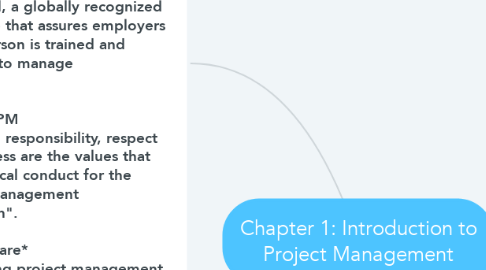Chapter 1: Introduction to Project Management
by Unknown TANG CHOON YEW

1. Project stockholders the people involved in or affected by project activities such as: 1.the project sponsor. 2.banks and other financial institutions. 3.the project manager. 4.the project team. 5.support staff. 6.suppliers. 7.opponents to the project.
2. Program and project portfolio management. -program (manage similar projects) a group of projects that are similar or related to one another, and which are often managed and coordinated as a group instead of independently -project portfolio management management, organizations group and manage projects and programs as a portfolio of investments that contribute to the entire enterprise’s success
3. Organizational project management: Framework in which portfolio, program, and project management are integrated with organizational enablers in order to achieve strategic objectives 4categories:HR,IT,Materials, Marketing. Discretionary costs: venture: Transform the business Growth: Grow the business Nondiscretionary costs: Core: Run the business
4. Role of the project manager work closely with the other stakeholders on a project, especially the sponsor and project team
5. Project Manager(PM) job description include responsibilities like planning, scheduling, coordinating, and working with people to achieve project goals PM profession is growing at a very rapid pace Project Management Institute credential, a globally recognized certificate that assures employers that a person is trained and qualified to manage projects. Ethics in PM "Honesty, responsibility, respect and fairness are the values that drive ethical conduct for the project management profession". PM software* performing project management helps project managers (PMs) and teams collaborate and meet goals on time while managing resources and cost.
6. Software Project Management is a project-refers to the branch of project management dedicated to the planning, scheduling, resource allocation, execution, tracking and delivery of software and web projects.
7. Project attribute: ->has a unique purpose. ->is temporary. ->drives change and enable value creation. ->is developed using progressive elaboration. ->requires resources, often from various areas. ->should have a primary customer or sponsor. ->involves uncertainty.
7.1. constraints: project manager knows (and often fears) the classic project constraints in project management: Time: What’s the deadline for delivering the output? Scope: What exactly is the expected outcome? Cost: How much money is available to achieve this outcome?
8. what is project management? The process of leading the work of a team to achieve goals and meet success criteria at a specified time.
9. project management knowledge areas? Project managers must have knowledge and skills in all 10 knowledge areas (scope, schedule, cost, quality, resource, communications, risk, procurement, stakeholder, and project integration management)
10. project management tools and techniques? Assist project managers and their teams in various aspects of project management: Project charter, scope statement, and WBS (scope). Gantt charts, network diagrams, critical path analysis, critical chain scheduling (time) Cost estimates and earned value management (cost).


